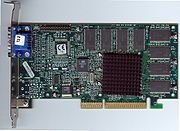
Voodoo3
Encyclopedia

3dfx
3dfx Interactive was a company that specialized in the manufacturing of 3D graphics processing units and, later, graphics cards. It was a pioneer in the field for several years in the late 1990s until 2000 when it underwent one of the most high-profile demises in the history of the PC industry...
. It was the successor to the company's high-end Voodoo 2 line and was based heavily upon the older Voodoo Banshee product. Voodoo3 was announced at COMDEX
COMDEX
COMDEX was a computer expo held in Las Vegas, Nevada, each November from 1979 to 2003. It was one of the largest computer trade shows in the world, usually second only to the German CeBIT, and by many accounts one of the largest trade shows in any industry sector...
'98 and arrived on store shelves in 1999. The Voodoo3 line was the first product manufactured by the combined STB Technologies and 3dfx.
History
The 'Avenger' graphics core was originally conceived immediately after Banshee. Due to mis-management by 3dfx, this caused the next-generation 'Rampage' project to suffer delays which would prove to be fatal to the entire company.Avenger was pushed to the forefront as it offered a quicker time to market than the already delayed Rampage. Avenger was no more than the Banshee core with a second texture mapping unit (TMU) added - the same TMU which Banshee lost compared to Voodoo2. Avenger was thus merely a Voodoo2 with an integrated 128-bit 2D video accelerator and twice the clock speed.
Architecture and performance



Highcolour
High color graphics is a method of storing image information in a computer's memory such that each pixel is represented by two bytes...
rendering limitation. This was in fact quite complex, as Voodoo3 operated to full 32-bit precision (8 bits per channel, 16.7M colours) in its texture mappers and pixel pipeline as opposed to previous products from 3dfx and other vendors, which had only worked in 16-bit precision.
To save framebuffer space, the Voodoo3's rendering output was dithered to 16 bit. This offered better quality than running in pure 16-bit mode. However, a controversy arose over what happened next.
The Voodoo3's RAMDAC
RAMDAC
Random Access Memory Digital-to-Analog Converter is a combination of three fast DACs with a small SRAM used in computer graphics display adapters to store the color palette and to generate the analog signals to drive a color monitor...
, which took the rendered frame from the framebuffer and generated the display image, performed a 2x2 box or 4x1 line filter on the dithered image to almost reconstruct the original 24-bit color render. 3dfx claimed this to be '22-bit' equivalent quality. As such, Voodoo3's framebuffer
Framebuffer
A framebuffer is a video output device that drives a video display from a memory buffer containing a complete frame of data.The information in the memory buffer typically consists of color values for every pixel on the screen...
was not representative of the final output, and therefore, screenshots did not accurately portray Voodoo3's display quality which was actually much closer to the 24-bit outputs of NVIDIA's RIVA TNT2
RIVA TNT2
The RIVA TNT2 was a graphics processing unit manufactured by Nvidia starting in early 1999. The chip is codenamed "NV5" because it is the 5th graphics chip design by Nvidia, succeeding the RIVA TNT . RIVA is an acronym for Real-time Interactive Video and Animation accelerator...
and ATI's Rage 128
ATI Rage
The ATI Rage is a series of graphics chipsets offering GUI 2D acceleration, video acceleration, and 3D acceleration. It is the successor to the Mach series of 2D accelerators.-3D RAGE :...
.
The internal organisation of Avenger was not complex. Pre-setup notably featured a guardband clipper (eventually part of hardware transformation and lighting) but the pixel pipeline was a conventional single-issue, dual-texture design almost identical to that featured on Voodoo2, but capable of working on 32-bit image data as opposed to Voodoo2's pure 16-bit output. Avenger's other remarkable features included the 128-bit GDI accelerator
Graphics Device Interface
The Graphics Device Interface is a Microsoft Windows application programming interface and core operating system component responsible for representing graphical objects and transmitting them to output devices such as monitors and printers....
first debuted in Banshee. This 2D engine led the Voodoo3 to be considered one of the more high-performance video cards of its generation.
The Voodoo3 2000, 3000 and 3500 differed mainly in clock frequencies (memory and core were synchronous). The clock rates were 143 MHz
Hertz
The hertz is the SI unit of frequency defined as the number of cycles per second of a periodic phenomenon. One of its most common uses is the description of the sine wave, particularly those used in radio and audio applications....
, 166 MHz and 183 MHz respectively. While this gave the 3000 and 3500 a notable theoretical advantage in multi-textured fillrate over its main rival, the 125 MHz TNT2,the TNT2 had nearly twice the single-textured fillrate of the Voodoo3. In addition, the Voodoo3 consisted of one multi-texturing pipeline, the TNT series consisted of twin single texturing pipelines. As a result, Voodoo3 was disadvantaged in games not using multiple texturing. The 2000 and 3000 boards generally differed in their support for TV output; the 3500 boards also carried a TV tuner and provided a wide range of video inputs and outputs.
At the time modern multi-texturing games such as Quake3 and Unreal Tournament
Unreal Tournament
Unreal Tournament is a futuristic first-person shooter video game co-developed by Epic Games and Digital Extremes. It was published in 1999 by GT Interactive. Retrospectively, the game has also been referred to as UT99 or UT Classic to differentiate it from its numbered sequels...
were considered Voodoo3's performance territory, as Voodoo3's primary competition upon release was the dated RIVA TNT. NVIDIA's RIVA TNT2 arrived shortly thereafter and the two traded places frequently in benchmark results.
Voodoo3 remained performance competitive throughout its life, eventually being comprehensively outclassed by NVIDIA's GeForce 256
GeForce 256
The GeForce 256 is the original release in Nvidia's "GeForce" product-line. Released on August 31, 1999, the GeForce 256 improves on its predecessor by increasing the number of fixed pixel pipelines, offloading host geometry calculations to a hardware transform and lighting engine, and adding...
and ATI's Radeon
Radeon R100
The Radeon R100 is the first generation of Radeon graphics chips from ATI Technologies. The line features 3D acceleration based upon Direct3D 7.0 and OpenGL 1.3, and all but the entry-level versions offloading host geometry calculations to a hardware transform and lighting engine, a major...
. 3dfx created the ill-fated Voodoo 5
Voodoo 5
The Voodoo 5 was the last and most powerful graphics card line that 3dfx Interactive released. All members of the family were based upon the VSA-100 graphics processor. Only the single-chip Voodoo 4 4500 and dual-chip Voodoo 5 5500 made it to market....
to counter.
3dfx Velocity
3dfx released a line of business / value-oriented cards based on the Voodoo3 Avenger chipset. With the purchase of STB Technologies, 3dfx had acquired several popular brand names. The Velocity brand had appealed to OEM system builders for years, with boards such as the S3 GraphicsS3 Graphics
S3 Graphics, Ltd is an American company specializing in graphics chipsets. Although they do not have the large market share that they once had, they still produce graphics accelerators for home computers under the "S3 Chrome" brand name.-History:...
ViRGE VX
S3 ViRGE
The S3 Virtual Reality Graphics Engine graphics chipset was one of the first 2D/3D accelerators designed for the mass market.-Introduction:...
-based STB Velocity 3D and NVIDIA
NVIDIA
Nvidia is an American global technology company based in Santa Clara, California. Nvidia is best known for its graphics processors . Nvidia and chief rival AMD Graphics Techonologies have dominated the high performance GPU market, pushing other manufacturers to smaller, niche roles...
RIVA 128
RIVA 128
Released in late 1997 by Nvidia, the RIVA 128, or "NV3", was one of the first consumer graphics processing units to integrate 3D acceleration in addition to traditional 2D and video acceleration...
-based Velocity 128 being used in many OEM systems from companies such as Gateway
Gateway, Inc.
Gateway Computer Corporation, is a computer hardware company headquartered in Irvine, California, USA which develops, manufactures, supports, and markets a wide range of personal computers, computer monitors, servers, and computer accessories...
. The 3dfx Velocity boards came with only 8 MiB of RAM, compared to 16 MiB on a regular Voodoo3. In addition, one of the texture management units came disabled as well, making the board more like a Banshee. Enthusiasts discovered that it was possible to enable the disabled TMU with a simple registry alteration. The board's clock speed was set at 143 MHz, exactly the same as a Voodoo3 2000.
Drivers
The last set of drivers officially released for the Voodoo 3 on Win9x was version 1.07.00. For Win2000 the latest version is 1.03.00. After 3dfx shut its doors 3rd party drivers for Windows 98/98SE and XP were developed by loyal 3dfx customers.Competing chipsets
- NVIDIA RIVA TNT2RIVA TNT2The RIVA TNT2 was a graphics processing unit manufactured by Nvidia starting in early 1999. The chip is codenamed "NV5" because it is the 5th graphics chip design by Nvidia, succeeding the RIVA TNT . RIVA is an acronym for Real-time Interactive Video and Animation accelerator...
- ATI Rage 128ATI RageThe ATI Rage is a series of graphics chipsets offering GUI 2D acceleration, video acceleration, and 3D acceleration. It is the successor to the Mach series of 2D accelerators.-3D RAGE :...
- Matrox G400Matrox G400The G400 is a video card made by Matrox, released in September 1999. The graphics processor contains a 2D GUI, video, and Direct3D 6.0 3D accelerator...
- S3 Graphics Savage4S3 SavageSavage was a product-line of PC graphics chipsets designed by S3.-Savage 3D:At the 1998 E3 Expo S3 introduced the first Savage product, Savage3D. Compared to its ViRGE-derived predecessor , Savage3D was a technological leap forward...

